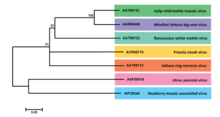| Ophiovirus | |
|---|---|

| |

| |
| (top) Electron micrograph of Citrus psorosis ophiovirus; (bottom) Mirafiori lettuce big-vein virus genome | |
| Virus classification | |
| (unranked): | Virus |
| Realm: | Riboviria |
| Kingdom: | Orthornavirae |
| Phylum: | Negarnaviricota |
| Class: | Milneviricetes |
| Order: | Serpentovirales |
| Family: | Aspiviridae |
| Genus: | Ophiovirus |
| Species | |

Aspiviridae, formerly Ophioviridae, is a family of segmented negative-strand RNA viruses which infect plants. Member viruses are characterized by an elongated and highly filamentous and flexible nucleocapsid with helical symmetry. It is a monotypic taxon containing only one genus, Ophiovirus. Aspiviridae is also the only family in the order Serpentovirales, which in turn is the only order in the class Milneviricetes.
History
The name Aspiviridae derives from the Latin aspis (snake or viper), referring to the shape, along with the suffix for a virus family -viridae. Ophiovirus derives from the Ancient Greek ophis, "snake", with –virus the suffix for a virus genus. Likewise, Serpentovirales is from "serpent" with -virales the suffix for a virus order. Milneviricetes is in honor of Robert G. Milne, the last author on the first paper describing ophioviruses.
Virology
Structure
The protein capsid is non-enveloped and has a constant diameter of 1500–2500 nm and a width of 3 nm, or 9 nm. The capsids form kinked circles, which can collapse to form linear duplex structures, much like a spring.
Genome
Member viruses have segmented, negative-sense, single-stranded RNA genomes. The entire genome is 11000–12000 nucleotides long.
Taxonomy

The family has one genus, Ophiovirus, which has seven recognized species. Members of both the family and the genus are referred to as ophioviruses.
- Family: Aspiviridae
- Genus: Ophiovirus
- Species: (Past name; New name)
- Blueberry mosaic associated ophiovirus; Ophiovirus vaccinii
- Citrus psorosis ophiovirus; Ophiovirus citri
- Freesia sneak ophiovirus; Ophiovirus freesiae
- Lettuce ring necrosis ophiovirus; Ophiovirus lactucae
- Mirafiori lettuce big-vein ophiovirus; Ophiovirus mirafioriense
- Ranunculus white mottle ophiovirus; Ophiovirus ranunculi
- Tulip mild mottle mosaic ophiovirus; Ophiovirus tulipae
- Species: (Past name; New name)
- Genus: Ophiovirus
References
- García, María Laura; Bó, Elena Dal; da Graça, John V.; Gago-Zachert, Selma; Hammond, John; Moreno, Pedro; Natsuaki, Tomohide; Pallás, Vicente; Navarro, Jose A.; Reyes, Carina A.; Luna, Gabriel Robles; Sasaya, Takahide; Tzanetakis, Ioannis E.; Vaira, Anna María; Verbeek, Martin (21 June 2017). "ICTV Virus Taxonomy Profile: Ophioviridae". Journal of General Virology. 98 (6): 1161–1162. doi:10.1099/jgv.0.000836. PMC 5656789. PMID 28635587.
- "Virus Taxonomy: 2018 Release". International Committee on Taxonomy of Viruses (ICTV). Retrieved 14 January 2019.
- ^ "ICTV Report Ophioviridae".
- ^ Wolf, Yuri; Krupovic, Mart; Zhang, Yong Zhen; Maes, Piet; Dolja, Valerian; Koonin, Eugene V.; Kuhn, Jens H. "Megataxonomy of negative-sense RNA viruses" (docx). International Committee on Taxonomy of Viruses (ICTV). Retrieved 12 January 2019.
- "Aspiviridae – Aspiviridae – Negative-sense RNA Viruses - ICTV". talk.ictvonline.org. Retrieved 2020-12-09.
- García, Maria Laura; Dal Bó, Elena; Grau, Oscar; Milne, Robert G. (1 December 1994). "The closely related citrus ringspot and citrus psorosis viruses have particles of novel filamentous morphology". Journal of General Virology. 75 (12): 3585–3590. doi:10.1099/0022-1317-75-12-3585. ISSN 0022-1317. OCLC 107178738. PMID 7996151.
- ICTVdB Management (2006). 00.094.0.01. Ophiovirus. In: ICTVdB—The Universal Virus Database, version 4. Büchen-Osmond, C. (Ed), Columbia University, New York, USA.
External links
| Taxon identifiers | |
|---|---|
| Aspiviridae | |
| Ophiovirus | |
| Ophioviridae | |
| Serpentovirales | |
| Milneviricetes | |